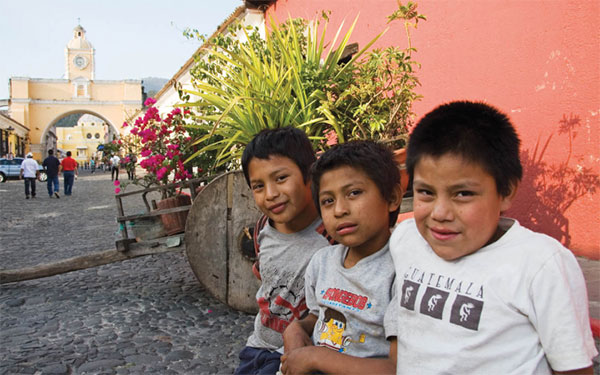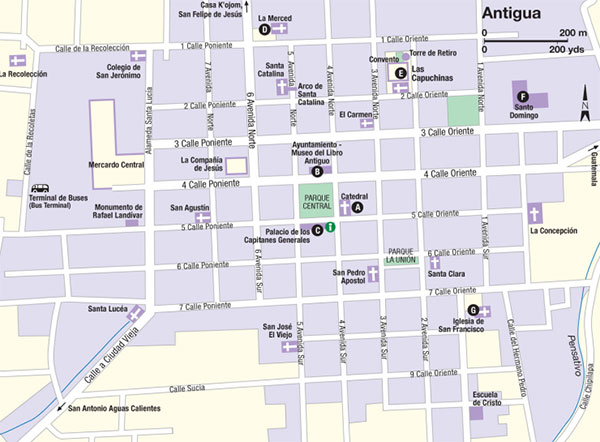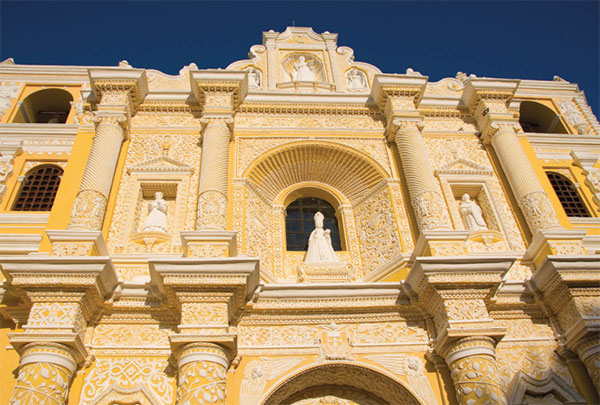The Parque Central
The heart of Antigua is the Parque Central, the delightful main square, popular night and day with locals and visitors who come to soak up the atmosphere. The park is bounded on all four sides by graceful colonial buildings that represented the epicenter of the Spanish empire in Central America for more than 200 years, now occupied by local government offices and museums. Note the risqué fountain (where topless mermaids spurt water from their nipples) in the center of the square.

Children by the Arco de Santa Catalina, Antigua.
Corrie Wingate/Apa Publications
The Catedral A [map] (hours vary, but generally open daily 9am–5pm) on the east of the square dates from 1669, although it was built on the ruins of an earlier structure that dated back to 1543. The Catedral survived the 1717 earthquake, but was all but reduced to rubble after the 1773 tremors. What is left today is only about a third of the original building, which measured almost 100 meters (330ft) in length and had a 21-meter (69ft) dome, twin bell towers, three naves, and eight domed bays. Inside, the Catedral sparkled in a riot of tortoiseshell, marble, and bronze. Now the building is much more perfunctory, with most of the original in ruins to the rear and the interior relatively bare. Below the Catedral are several crypts and the remains of the Royal Chapel, and supposedly the remains of many historic figures, including Pedro de Alvarado, Francisco Marroquín, and Bernal Díaz de Castillo.
Tip
Antigua’s beauty is magnified during its most important (and colorful) festival: Holy Week. Costumed processions parade through the central streets, which are carpeted with colorfully dyed sawdust laid out in patterns. Keep in mind that it is difficult to find a hotel in town at this time, so consider staying in Guatemala City or even Lago de Atitlán.
On the north side of the square is the Ayuntamiento B [map] , the city’s municipal offices, with its twin-deck facade of solid stone arches built in a Tuscan style. This has hardly changed in appearance since it was built in 1740, surviving both the 1773 and 1976 earthquakes. In the Ayuntamiento, you’ll find the small but well curated Museo del Libro Antiguo (Tue–Fri 9am–4pm, Sat–Sun 9am–noon, 2–4pm), dedicated to publishing, where there is a replica of the first printing press in Central America. Facing the Ayuntamiento on the other side of the parque is the Palacio de los Capitanes Generales C [map] (Wed–Sun 9am–4.30pm). The two-story colonnaded building dates from 1761 and was the nucleus of power in Central America for over two centuries, home not only to the colonial rulers but also the Courts of Justice, the Mint, a prison, and barracks.

Around the plaza
The Arco de Santa Catalina, one of the great Antiguan landmarks, was built in 1693 to connect the convent of Santa Catalina to orchards and gardens on the other side of the street so that the nuns could cross the street without fear of contamination by the outside world. The arch was later restored in the 19th century. Continuing up 5 Avenida is the church of La Merced D [map] (ruins daily 8.30am–5.30pm, church daily 7am–noon, 3–8pm), whose ‘wedding cake’ facade is the finest in all Antigua, fully restored and painted a fantastic shade of yellow with white detail. Inside, at the end of the south nave is the figure of Jesus Nazarene, sculpted by Alonso de la Paz in 1650, and in the ruins of the adjacent cloisters a fountain that is said to be the largest in Central America. Perhaps the most evocative of all Antigua’s ruins are Las Capuchinas E [map] (2 Avenida Norte and 2 Calle Oriente; daily 9am–5pm; charge), in the north of the city. The Capuchin order was an extremely strict splinter group of the Franciscans: nuns were permitted no contact at all with the outside world. The unique (and intriguing) feature at Las Capuchinas is the Torre de Retiro (Tower of Retreat), a circular courtyard of 18 tiny cells thought to have been a retreat cloister for nuns. Don’t miss the fine museum, which has some impressive religious art and ecclesiastical artifacts. Santo Domingo F [map] (3 Calle Oriente; www.casasantodomingo.com.gt; Mon–Sat 9am–6pm, Sun 11am–6pm), once a monastery, is now an upscale hotel, cultural center, and museum complex. The site given to the Dominicans in 1541 was the largest occupied by any religious body, and the monastery grew to become the wealthiest order in the city. It also started up a college for the study of theology, philosophy, art, Latin, and Mayan language, which in 1676 was established as the University of San Carlos. Santo Domingo was reduced to rubble in 1773, but a superb restoration has transformed much of the site. A series of museums cover religious treasures from the Spanish era, Maya artifacts and ceramics, fascinating crypts, a re-creation of an early pharmacy, and more. Just north of the monastery is Santo Domingo del Cerro, an art and culture park featuring contemporary sculptures – and gorgeous views of Antigua.

La Merced.
Corrie Wingate/Apa Publications
The mighty Iglesia de San Francisco G [map] (1 Avenida Sur; daily 9am–5.30pm) is most notable for the tomb and shrine of Hermano Pedro de Betancourt, a teacher-friar who tirelessly cared for the sick and the poor and established hospitals and convalescent homes. Today hundreds of Guatemalans visit his shrine to ask for his help, and he is credited with many miracles. Don’t miss the extensive ruins and small museum in the church.
Around Antigua
There are some fascinating sights in the stunning countryside of pine trees, coffee bushes, and volcanoes around Antigua, and many interesting villages, both Indigenous and ladino. It is best to explore the area as a series of day and half-day trips, using Antigua as your base. San Andrés Itzapa 4 [map] has a Tuesday market, but is best known for its shrine to the pagan saint of Maximón. It is customary to light a candle or two in Maximón’s chapel (daily 6am–6pm) to ask for good fortune, but if you want to take things further, pay one of the cigar-smoking women attendants for a limpía (soul cleansing), which involves you drinking aguardiente liquor and getting thrashed by a bundle of herbs.
North of the Interamericana there are three more villages worth a visit. San Martín Jilotepeque is a pleasant place with an excellent Sunday market, with beautiful local huipiles. At Comalapa to the west, there is a long-established tradition of primitiva (folk art) painting, with plenty of artwork on sale locally and also the spectacular crumbling Baroque facade of the village church. Market day is on Tuesday in Comalapa. Heading in the other direction toward Guatemala City along the Interamericana highway, the village of Santiago Sacatepéquez is famous throughout Guatemala for its giant kites, constructed by the villagers every year to be flown on the Day of the Dead (November 1). The kites, which can be up to 7 meters (23ft) in diameter, are flown in a symbolic act to release the souls of the dead.